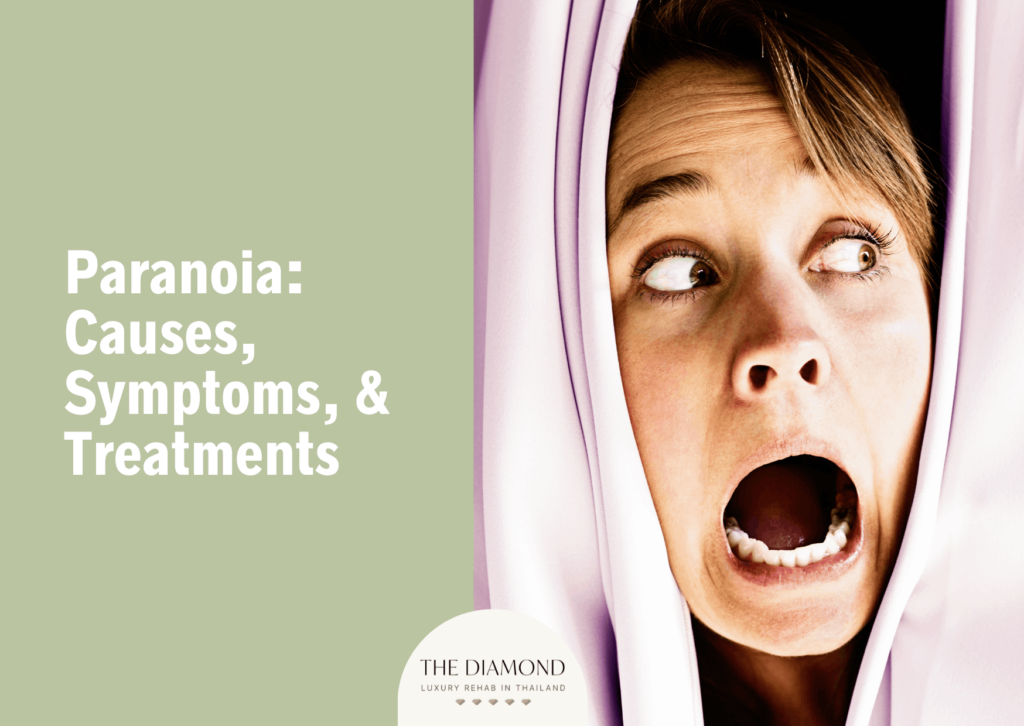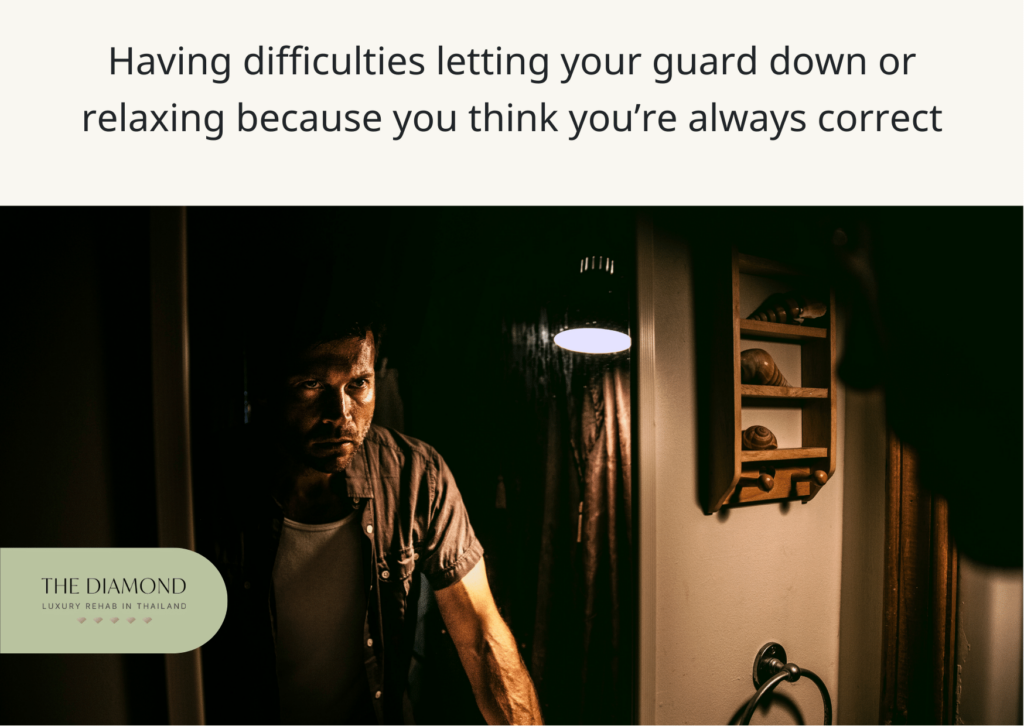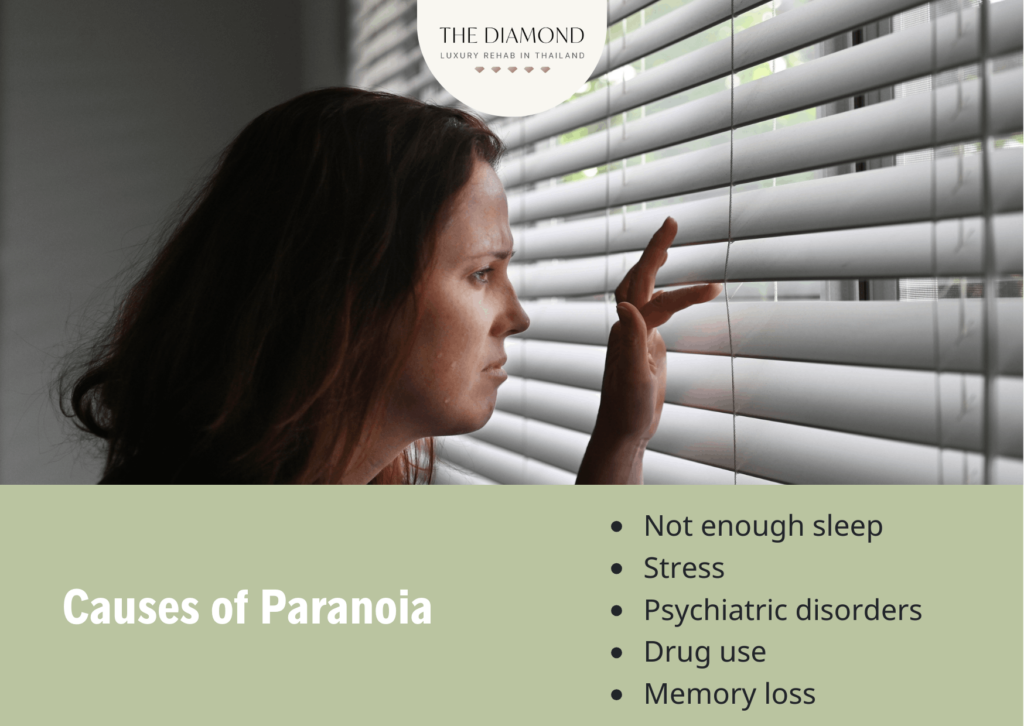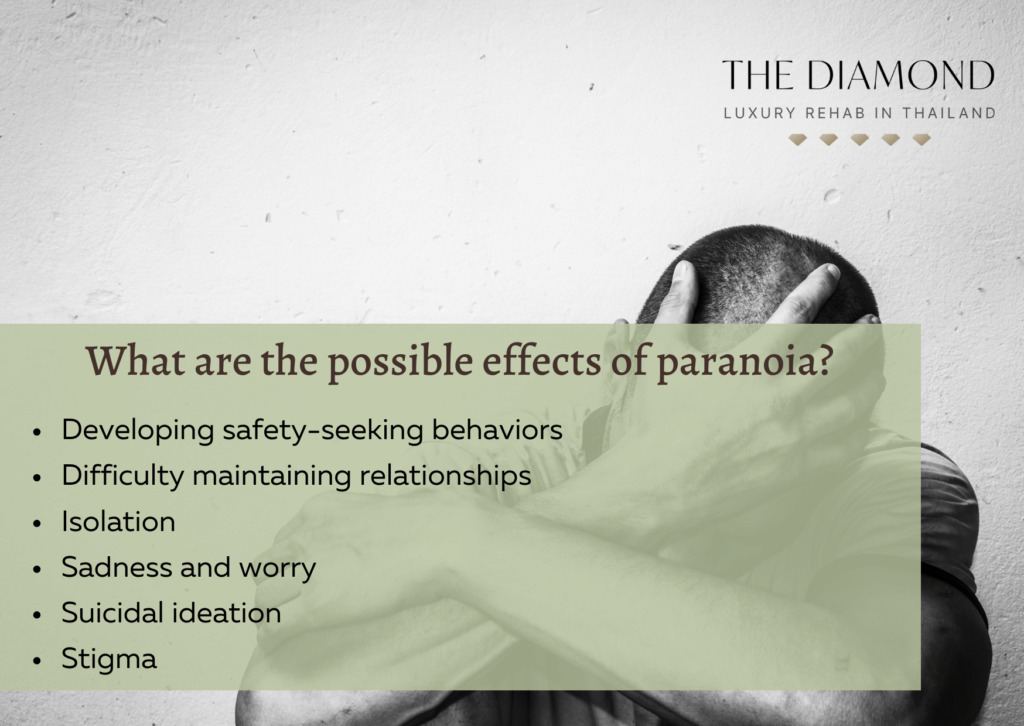Paranoia: causes, symptoms, and treatments
Table of content
- What is paranoia?
- What are the symptoms of paranoia?
- 1. Being confrontational, belligerent, and defensive
- 2. Being sensitive to offense
- 3. Having difficulties letting your guard down or relaxing because you think you’re always correct
- 4. Being unable to pardon yourself, forgive others, or take criticism
- 5. Being unable to confide in or trust others
- 6. Interpreting hidden messages in people’s everyday actions
- What are the causes of paranoia?
- What are the different types of paranoia?

Paranoia is a mental state wherein a person feels they are being threatened somehow. An individual with paranoia feels unsafe and believes other people are against them, even if they have no evidence to prove anything.
The causes of paranoia involve a combination of different factors, including sleep deprivation, stress, drug use, mental health disorders, and memory loss.
Symptoms of paranoia include confrontational and aggressive behavior, increased sensitivity to offense, beliefs of being always right, difficulty taking criticism, lack of trust in others, and interpreting hidden messages and people’s behaviors.
The most common treatment approaches for paranoia are medications, therapy, coping skills, and, in the most severe cases, hospitalization.
What is paranoia?
Paranoia is defined as the irrational and persistent feeling of being threatened, unsafe, or lied to even if there is no evidence for such claims. The term paranoia has a Greek origin and is a combination of para (beyond, irregular) and noos (mind).
In other words, paranoia is the irregularity of the mind that produces irrational and obsessive distrust of others. The word paranoia was first used during plays by Greek tragedians, and was used by Hippocrates and Plato as well. At the time, it was mainly taken as the equivalent of high fever or delirium.
Paranoia itself is not a specific disease, but it is present as a symptom or a major component of several mental health conditions.
Paranoia has been around for thousands of years. One of the earliest descriptions of paranoia or paranoid personality comes from Valentin Mangan, a French psychiatrist. He described the case of fragile personality indicated by undue sensitivity, idiosyncratic thinking, hypochondriasis, suspiciousness, and referential thinking.
Although the term paranoia has been used since ancient times, the understanding of this mental state was quite poor. In 1621, Robert Burton, an English writer, published the book The Anatomy of Melancholy where he introduced the concept of paranoia with a more modern meaning.
A major contribution to the understanding of paranoia came in 1818 when Johann Christian August Heinroth, a German physician, described it as a disorder of thought with unaltered perceptions. German and French psychiatry at the time agreed that paranoia was a partial psychosis with a maintained functioning level and absence of deterioration.
Over the years, various psychiatrists and scientists worked on learning as much as possible about paranoia. One of them was Emil Kraepelin, 1921, who gave the most precise description of paranoia. This German psychiatrist described both psychogenic and biological components.
Certain people have mild paranoia whereas others have a severe form of this mental state. To diagnose paranoia, a healthcare provider often performs a medical exam and takes a medical history to rule out physical or medical reasons behind paranoid thoughts and behavior.
If paranoia is a psychiatric issue, the doctor is going to refer the patient to a psychiatrist or psychologist. They are going to perform a psychological evaluation to determine a patient’s mental status. Once a diagnosis is confirmed, the doctor then recommends the most suitable treatment approach.
Generally speaking, the outlook for persons with paranoia is positive when they seek treatment in a timely manner and adhere to the treatment protocol.
What are the symptoms of paranoia?

Symptoms of paranoia refer to a cluster of behaviors and beliefs characterized by an intense and irrational distrust or suspicion of others, often without evidence or justification. The symptoms of paranoia are listed below.
- Being confrontational, belligerent, and defensive
- Being sensitive to offense
- Having difficulties letting your guard down or relaxing because you think you’re always correct
- Being unable to pardon yourself, forgive others, or take criticism
- Being unable to confide in or trust others
- Interpreting hidden messages in people’s everyday actions
1. Being confrontational, belligerent, and defensive
Being confrontational, belligerent, and defensive are indicative of underlying paranoid tendencies. In the context of paranoia, individuals exhibit an exaggerated sensitivity to perceived threats, leading them to respond aggressively or defensively to even minor or imagined provocations.
A person with paranoia believes their thinking pattern is the reality i.e. the truth, which is why they become confrontational and aggressive. Paranoia changes the way a person perceives reality, and paranoid thoughts tend to be intense and persistent.
People with paranoia believe someone wants to harm them or demean them in a certain way. They are likely to confront those persons and become aggressive even when they have no evidence to support their claims. Since they’re feeling threatened or have paranoid thoughts that paint a different picture of reality, persons with paranoia become defensive as well.
In order to identify these symptoms, it’s important to closely observe someone’s behavior. Confrontational or aggressive individuals tend to choose words or actions purposely to push buttons and keep a person off balance. That way, they create an advantage from which they’re able to exploit someone’s weakness. This weakness sometimes serves as “evidence” of being right about those people.
Persons with paranoia tend to engage in arguments and disputes quite often. While doing so, they use accusatory words to express their beliefs about the supposed intentions of the other person.
2. Being sensitive to offense
Being sensitive to offense is a common symptom associated with paranoia, where individuals exhibit an exaggerated reaction to perceived slights, criticisms, or insults, often interpreting benign comments or actions as intentional attacks against them.
A person with paranoia is often hypersensitive, and their self-esteem is very low. Combined, these factors make an individual with paranoia more sensitive to offense. In other words, they get offended easily.
Paranoid thoughts represent reality differently. Someone’s actions do not appear genuine, hence a person believes they can’t trust them. In these situations, it’s easy to regard everything as offensive. An individual with paranoia is inclined to think that someone wants to humiliate them on purpose. However, in reality, that specific person has no such intentions. Instead, paranoia makes people feel like they’re victims.
Identifying this symptom of paranoia in oneself or others isn’t that difficult. Being overly sensitive to everything, feeling offended, victimized, or like everyone’s against you are the telltale signs.
3. Having difficulties letting your guard down or relaxing because you think you’re always correct

This symptom frequently manifests as an unwavering conviction that those suffering from paranoia are always right in their perceptions, assessments, and behaviors, which causes them to remain vigilant and aware all the time. This way of thinking stems from a pervasive fear of being tricked, misled, or shown to be incorrect, as well as a deep-seated mistrust of other people.
Paranoia is a type of mental health problem where people believe others are lying or being unfair. Constantly oppressed by negative, paranoid thoughts about others, a person is constantly looking out for danger. They can’t relax mainly because in these situations a person believes something is going to happen. In their minds, persons with paranoia are always correct.
A person without paranoia usually doesn’t assume their thoughts are always true. They leave the possibility that they aren’t right all the time. However, for someone with paranoia, paranoid thoughts about other people are all the truth they need. They don’t do it on purpose, paranoia changes the way a person perceives reality and other people. So, beliefs that others lie, cheat, deceive, and aim to harm or threaten become facts in their minds.
To identify this symptom, it’s necessary to consider whether a person has chronic anxiety. They tend to appear on the edge always, can’t “chill” or relax, and refuse to change their mind. A person with paranoia sticks to their conclusions or assumptions even when there’s no proof to support them.
4. Being unable to pardon yourself, forgive others, or take criticism
This symptom frequently manifests as struggling to forgive and understand people because they hold intense negative emotions towards them, such as resentment, hostility, and distrust. They perceive any criticism or feedback as a personal attack or confirmation of their beliefs that others are out to harm them.
An individual with paranoia is unable to pardon themselves for things they see as mistakes and at the same time, they can’t forgive others. They usually aren’t able to compromise. This is associated with the belief that they’re always right. For that reason, forgiveness isn’t something they practice.
If they believe someone wants to harm them, they won’t be able to forgive that person even if their conclusion was wrong. Since a person with paranoia believes their thinking pattern is always correct, they’re unable to accept criticism or accept they are wrong.
It’s not difficult to identify these symptoms. A person doesn’t take criticism or presume it’s something constructive. Instead, they take it as an insult. They are often strict with others and themselves, leave no space for mistakes, and refuse to let things go.
5. Being unable to confide in or trust others
One’s reluctance to confide in others is fueled by a belief that revealing too much about oneself exposes vulnerabilities that have the potential to be exploited by others. Additionally, individuals with paranoid tendencies perceive innocuous actions or statements from others as evidence of ulterior motives or hidden agendas, further reinforcing their distrust.
Paranoia manifests itself as a lack of trust in other people, including their significant other. A person with paranoia constantly feels someone is cheating on them. They assume the other person is always lying or wants to harm them. Since they negatively perceive the other person, they can’t trust them or confide in them. This often leads to feelings of loneliness and isolation.
It’s useful to keep in mind that trust issues and paranoia aren’t the same. Having trust issues is usually caused by some specific problem that a person doesn’t want to relive again. On the flip side, paranoia is an intense, irrational suspicion and mistrust.
6. Interpreting hidden messages in people’s everyday actions
Interpreting hidden messages in people’s everyday actions is a characteristic symptom of paranoia, where individuals perceive underlying meanings or intentions in seemingly ordinary behaviors or communications. This phenomenon occurs due to an increased sensitivity to perceived threats and a widespread conviction that others are plotting against them.
An individual with paranoia starts analyzing or deciphering the behavior of a specific person or more people, because paranoia makes a person mainly focused on the perceived threat or harm. They look for clues and hidden messages in people’s behaviors. At times, they are convinced that certain behaviors are evidence to support their claims, but in reality, that is far from true.
One is able to spot this symptom in themselves or others by focusing on their actions. If the person is extremely focused and thinks about someone’s motives or hidden messages or clues, it’s highly likely they have a certain form of paranoia.

What are the causes of paranoia?
The exact causes of paranoia are unclear, it is thought that various factors contribute to its development. The most common contributing causes of paranoia are listed below.
- Not enough sleep
- Stress
- Psychiatric disorders
- Drug use
- Memory loss
1. Not enough sleep
Not getting enough sleep is recognized as one of the potential causes of paranoia. When individuals do not obtain adequate sleep, their brain’s ability to process information and regulate emotions becomes compromised, making them more susceptible to distorted thinking patterns and exaggerated perceptions of threat.
According to a 2009 paper by Freeman et al., from Schizophrenia Research, numerous sufferers of persecutory delusions struggle to fall asleep and remain asleep. Insomnia causes a decrease in mood and abnormal experiences that contribute to persecutory ideation.
Lack of sleep contributes to the development of paranoia through several mechanisms of action. For instance, sleep deprivation contributes to or worsens anxiety and depression. Both mood disorders make it easier for paranoia to appear. Additionally, lack of sleep leads to a puzzling internal state for a person that, in the anxiety context, is incorrectly associated with an external threat.
A paper by Rehman et al., published in the January 2018 issue of Psychiatry Research explained that, although a lot more studies are necessary, sleep problems are associated with paranoia through negative moods and alexithymia, an inability to identify and describe emotions experienced by oneself.
Sleep quality is a factor in the development of paranoia, which means that insomnia isn’t the only issue that leads to paranoid thoughts. Sleep deprivation comes in different forms, such as failing to get enough sleep during the night or not having a healthy sleep schedule.
A person who doesn’t get enough sleep, especially when the problem persists, is more likely to develop paranoid or delusional thinking. However, this doesn’t automatically mean every person with a lack of sleep is bound to develop paranoia. Other factors are involved as well.
2. Stress
Stress is a normal human reaction to pressure, feeling threatened, and other negative stimuli. Not all stress is bad, but when left unmanaged, it turns into a huge problem and negatively affects a person’s mental health. Long-term stress increases the risk of mental health problems such as anxiety and depression. It additionally contributes to the development of paranoia.
A 2009 study by Lincoln et al., published in Psychological Medicine confirmed the rise in depressive symptoms, anxiety, and unfavorable feelings under stress. Vulnerability likely acts as a moderating factor and anxiety presumably mediates the increase in paranoia.
Furthermore, The Schizophrenia Bulletin published a study by Veling et al., in 2016 that found that environmental social stress caused a dose-dependent increase in paranoia and subjective distress. More stressors led to higher levels of paranoia.
Men and women with high-stress levels are more likely to experience paranoid thoughts because they are vulnerable. When a person is stressed out and vulnerable, they’re more prone to having negative thoughts and bad moods, all of which pave the way to paranoia. The relationship between stress and paranoia is particularly strong in people who already have mental health problems.
Plus, it’s useful to mention that sleep deprivation is an essential component of what stress is. Lack of sleep contributes to stress, and their relationship is bidirectional.
3. Psychiatric disorders
Psychiatric disorders comprise an extensive spectrum of mental health conditions distinguished by disruptions in behavior, cognitive processes, and emotions. These disorders frequently involve disturbances in mood regulation, cognition, and perception, which function as fundamental origins of paranoia.
People with conditions such as anxiety, depression, schizophrenia, and certain personality disorders are more susceptible to experiencing paranoid thoughts or being more upset by them.
It’s not entirely clear why it happens, but individuals with these conditions tend to be more on edge or they worry a lot. In addition, they are more likely to interpret things negatively.
To explain the relationship between psychiatric disorders and paranoia, we’re going to focus on 5 psychiatric disorders – anxiety, depression, schizophrenia, paranoid personality disorder (PPD), and delusional disorder.
Anxiety is defined as the feeling of unease, intense fear, or worry, that is either mild or severe. It often worsens with time. One of the main components of anxiety is the presence of unusual or irrational thoughts, which is the connection between anxiety and paranoia.
A paranoid thought is a type of anxious thought, which is why anxiety contributes to the development or worsening of paranoia. It affects what a person is paranoid about and how long the feeling lasts.
A 2010 paper by Lincoln et al., from the Schizophrenia Bulletin revealed anxiety increases paranoia and leads to the tendency to jump to conclusions. The degree of pre-existing symptoms moderated the relationship between anxiety and paranoia, while an increase in the propensity to hastily draw conclusions mediated the association. Furthermore, findings from fundamental research have shown that anxiety has a tendency to reduce focus on emotionally significant signals.
Depression is a mental health problem that contributes to the development of paranoia. The likelihood of developing paranoia is a lot higher in individuals with comorbid depression and anxiety.
Social Psychiatry and Psychiatric Epidemiology published a 2016 study by Salokangas et al., that confirmed that one of the most significant clinical predictors of persistent paranoid symptoms among clinical high-risk patients was depressive disorder. People with depression tend to have low self-esteem, which is associated with certain types of paranoia as well.
When discussing depression as a potential cause of paranoia, it’s important to mention depressive psychosis. It is a combination of major depression and psychotic symptoms. The latter include hallucinations, delusions, and paranoia. Chemical imbalances are considered the main cause of depressive psychosis. This shows once again that depression and paranoia are linked to one another.
Schizophrenia is strongly related to paranoia. In fact, paranoia is one of the most common symptoms of this severe mental health condition. It’s not entirely clear what causes paranoid schizophrenia, but factors such as a combination of genetic mutations inherited from one or both parents, complications during pregnancy, and exposure to harmful chemicals and substances potentially play a role in its development. Patients with schizophrenia have an unrealistic perception of reality, which affects the way they think and behave.
Paranoid personality disorder (PPD) is another psychiatric disorder related to paranoia. A paranoid personality disorder is characterized by a pattern of distrust and suspicion of others without any reason to be suspicious.
People with PPD have persistent paranoid thoughts that someone wants to harm, demean, or threaten them. Although it’s unknown why it happens, a combination of biological and environmental factors likely leads to PPD and its main symptom – paranoia.Delusional disorder, a type of psychotic disorder, is tied to paranoia.
Delusional disorder is indicated by the presence of one or more delusions and paranoid thoughts. A person with this condition can’t make a distinction between what’s real and imagined. Stress is the most common trigger of delusional disorder and paranoid thoughts associated with it.
4. Drug use
Drug use includes the ingestion of chemicals, whether they are lawful or illicit, that modify brain activity and conduct. Due to how certain drugs affect the brain’s neurotransmitter systems and thinking processes, drug use is known to be a major cause of paranoia.
The use of certain recreational drugs contribute to the presence of paranoid thoughts. These include cocaine, LSD, ecstasy, amphetamines, and cannabis. Alcohol, as an addictive substance, leads to paranoia as well.
The effects of recreational drugs and other substances on paranoia are particularly strong when a person is already in a low mood, anxious, or experiencing other mental health problems. That being said, it is not entirely known why these drugs cause paranoia.
Taking excessively high amounts of some drugs results in drug-induced psychosis and the development of paranoid thinking. In these cases, paranoia happens because the level of toxicity of the substance induces paranoia and provokes a psychotic episode.
Recreational drugs hurt a person’s brain and interfere with their understanding of the world. This effect is stronger with heavy, long-term use. Since the perception of reality becomes twisted, a person becomes more prone to paranoid thoughts, jumping to conclusions, or focusing on irrational beliefs that are real to them.
Additionally, recreational drugs such as cannabis overstimulate the amygdala, the brain area that regulates emotional processes. Hyperactivity of the amygdala leads to paranoia. At that point, a person experiences an increase in anxiety, fear, and worry. They are more susceptible to feeling threatened by someone.
Other drugs, such as methamphetamine, increase brain activity and thereby pave the way to paranoid thoughts and rumination.
5. Memory loss
Memory loss occurs due to a wide range of causes including neurodegenerative conditions such as dementia and its most common type, Alzheimer’s disease. Patients with Alzheimer’s disease develop paranoia due to memory loss. For instance, an individual becomes paranoid if they forget where they put something, people around them, and directions.
In these cases, paranoia is a way the person is expressing loss. The affected individual blames others or accuses them of hiding things. They do so because their perception of reality has been changed and no alternative explanation appears to make sense, as per an article titled, “Alzheimer’s and Hallucinations, Delusions, and Paranoia” last reviewed in May 2017 by the National Institute on Aging.
A study by Sultzer et al., published in the November 2014 issue of The American Journal of Geriatric Psychiatry stated that delusions or paranoia are associated with memory deficits and they are caused by impairment in certain frontal and temporal cortical areas. The frontal lobe controls crucial functions associated with consciousness, communication, memory, and attention.
What are the possible effects of paranoia?

The possible effects of paranoia include consequences or implications it has on a patient, their overall quality of life, and other people. The biggest effects of paranoia are listed below.
- Developing safety-seeking behaviors: A person with paranoia develops safety behaviors i.e. do things that make them feel safe. For example, they wear protective clothing or avoid certain people and/or places. They do so because they are convinced someone wants to harm them. Safety-seeking behaviors appear odd to others, especially because paranoid thoughts are irrational. However, to the affected individual, those thoughts are real.
- Difficulty maintaining relationships: People with paranoia tend to question other people and their intentions a lot, even when they have no reason to doubt them. Plus, they tend to be argumentative and aggressive. For that reason, other people are likely to start avoiding them. It is difficult for a person with paranoia to maintain relationships, have friends, or get along with family members. Maintaining a relationship with a person with paranoia becomes particularly difficult if they refuse to seek help for their problem. This tends to be a major cause of relationship problems or impaired family dynamics. While other people are genuinely concerned and want to help their friends or family, a person with paranoia sees nothing wrong. In fact, they keep accusing others of wanting to harm them.
- Isolation: Paranoid thoughts make a person feel totally alone. They feel as if nobody understands them. It tends to be quite lonely when other people don’t know what feels real to someone. Even if a person with paranoia doesn’t want to be isolated, their actions unintentionally push other people away. At the same time, isolation further affects their mood and contributes to paranoid thoughts and behaviors.
- Sadness and worry: A person with paranoia tends to worry about their paranoid thoughts and feel sad about their meaning and the effect on their life. For example, they become convinced someone they love is cheating on them. This makes a person sad because they feel betrayed by that person. When the partner isn’t around, they worry if they’re cheating. This leads to a vicious circle where accusations and insecurities are intertwined with sadness and worry. However, worry and sadness make a person more susceptible to paranoid thoughts and thereby worsen a person’s condition.
- Stigma: Even though we live in the 21st century, people with paranoia are still stigmatized. Paranoia is often mistaken for other mental health problems and people assume every person with paranoid thoughts is dangerous. The stigma surrounding paranoia makes a person reluctant to seek help, deepens their isolation, and worsens mental health. Dealing with stigma is particularly difficult when it’s present among family and friends.
- Health problems: Mental health has a strong influence on physical health and wellbeing. Paranoia paves the way to avoidable and treatable conditions. Patients with paranoia stop taking care of their health or they are unable to make rational decisions about their physical wellbeing. As a result, various health problems are not addressed and therefore go untreated. Plus, they don’t see the problem or refuse to take action when other people express their concerns.
- Suicidal ideation: Patients with paranoia are at a higher risk of suicidal thoughts and tendencies. A 2019 study by Freeman et al., from Comprehensive Psychiatry revealed patients with paranoia, especially the persecutory type, often face intense psychological distress and are very susceptible to suicidal tendencies, as seen by their pronounced levels of suicidal ideation. Suicidal thoughts and tendencies are more pronounced in people who have paranoia due to the presence of a serious mental health problem. A good example is schizophrenia.
- Unemployment: Paranoia, regardless of the cause, affects different aspects of a person’s life such as their career. Paranoid thoughts affect a person’s behaviors and jeopardize their work performance, teamwork functioning, making decisions, and problem-solving abilities. For example, an individual experiencing paranoia is likely to believe that their colleagues want to harm them, which directly affects their behavior and productivity.
What are the different types of paranoia?
Different types of paranoia involve different forms of paranoid reactions and underlying beliefs. Not all cases of paranoia are the same. Different types of paranoia are explained in detail and listed in the table below.
| Type of paranoia | Description | Characteristics |
| Persecutory paranoia | The most common type of paranoia. Persecution is the act of oppressing/harassing a person or a group of people. | Feeling targeted and beliefs of being surveilled, sabotaged, or harassed. A person becomes angry and attempts to stop these threats. |
| Grandiosity paranoia | Known as megalomania; another common type of paranoia. It refers to self-satisfying convictions. Rarely occurs on its own. They occur with persecutory paranoia or other conditions where a person’s perception of reality is impaired. | Beliefs of being strongly superior to others due to special powers or abilities. Patients with grandiosity and paranoia tend to be violent and argumentative. |
| Litigious paranoia | An unreasonable tendency to involve the law in everyday disputes. | Constant quarreling, persecution claims, and insistence that someone breached their rights. An affected person attempts to seek retribution e.g. by taking the matter to court. |
| Erotic or jealousy paranoia | Otherwise known as morbid jealousy, pathological jealousy, Othello syndrome, and conjugal paranoia; a delusional belief that someone’s spouse or sexual partner is being unfaithful. | Constant accusations of jealousy with questionable or dubious evidence. Sometimes a person accuses their partner of being unfaithful without any evidence to support their claims. A person with jealousy paranoia feels insecure and becomes too controlling in a relationship. They constantly accuse the other person of lying, cheating, and deceiving. |
What are the available paranoia treatments?

Paranoia treatment methods depend on the cause and severity of symptoms. Regardless of the treatment type, a person with paranoia needs to make lifestyle adjustments to support mental balance. Healthcare providers generally advise patients to exercise regularly, eat a healthy diet, and get enough sleep in addition to the recommended treatment option. The available treatment approaches for paranoia are listed below.
- Medications: A doctor prescribes medications to people whose paranoia is caused by paranoid personality disorder and schizophrenia. These usually include anti-anxiety medications, antidepressants, and antipsychotic medications. Medications additionally work for patients with co-occurring mental health problems such as depression. The role of medications is to decrease paranoid thoughts or make a person feel less threatened by them. Certain medications block the effect of dopamine to reduce the flow of messages it passes and thereby lessen the intensity of paranoia.
- Psychotherapy: This treatment approach helps patients develop coping skills to improve their communication and socialization. The most common type of therapy for patients with paranoia is cognitive-behavioral therapy (CBT). During CBT sessions, therapists help patients examine their thought patterns and understand that certain thoughts are irrational. Since CBT decreases worry and anxiety, it helps lessen paranoia. As patients learn to look at the way their thoughts and behaviors affect one another, they consider alternative interpretations. This reduces the focus on the irrational aspect. Besides individual therapy sessions, patients additionally need family therapy. Cognitive-behavioral therapy is particularly useful for teaching patients the above mentioned communication skills. Patients get an opportunity to learn to communicate with others more effectively or express their emotions. A major part of CBT is challenging or questioning irrational thoughts, thereby decreasing the effect of paranoia.
- Coping skills: The main goal is to help patients cope with their symptoms and improve their functioning or quality of life. Cognitive-behavioral therapy isn’t the only strategy for learning coping skills. Other approaches include relaxation techniques, behavior modification, and techniques to reduce anxiety. Relaxation techniques are incredibly helpful. By learning to relax or calm their mind, patients with paranoia pay less attention to their paranoid thoughts. Paranoia is stronger in times of stress and anxiety. That’s why relaxation techniques and mindfulness help a person cope with this mental state. Good relaxation techniques to try are meditation, deep breathing, and even yoga.
- Hospitalization: In severe cases, when other treatment approaches fail to work, a person with paranoia needs to stay in the hospital until their condition stabilizes. Admission into the hospital is necessary for patients with serious mental health conditions such as schizophrenia and major depression. Laws regarding hospitalization for persons with paranoia vary from one state to another. Generally speaking, hospitalization is recommended in cases when a person is unable to care for themselves or when they pose a threat or danger to themselves and other people.

